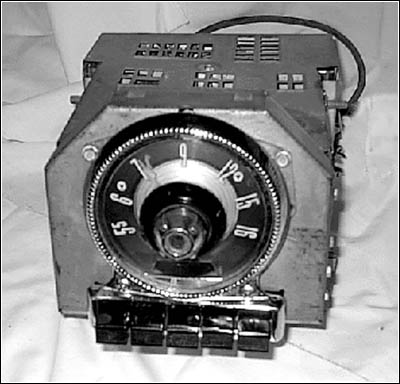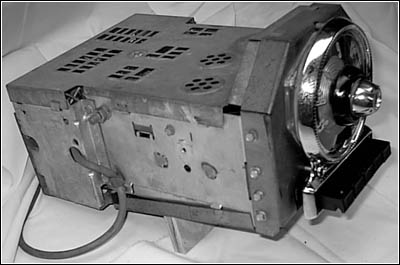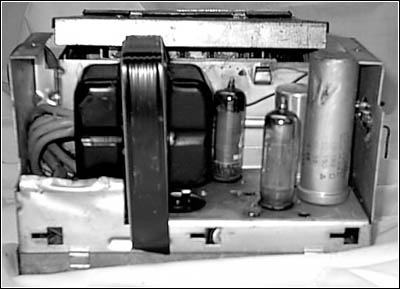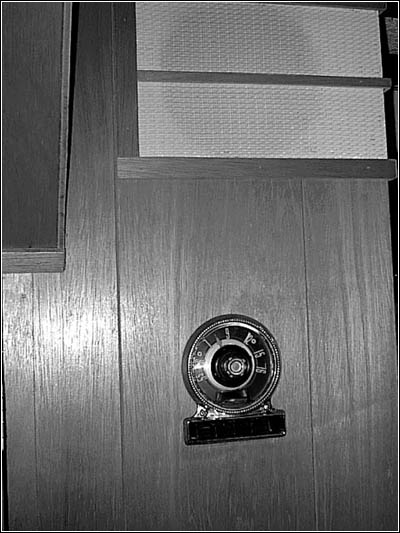Of Old Radios And Related Items--Published Monthly
Vintage Automobile Radios
by Walter H. Hall
Web Edition
In the article, Walter Hall provides some background information on car radios, and tells how he found a new application for an old set from a 1950 Ford. (Editor)
A number of years ago an acquaintance of mine brought to me a vintage automobile radio, which he had salvaged from a 1950 Ford. The car had suffered serious damage due to an unfortunate misunderstanding at an intersection. Since I had no immediate use for the radio, it sat on a shelf in my workshop for several more years.
One day out of curiosity, I decided to take a closer look at the radio, which fortunately showed no signs of deterioration due to the passage of time. I found the radio, shown in Figures 1 and 2, to be complete and undamaged. Typical of its time, it had an "airplane" type dial and five mechanical push buttons for selecting stations without having to look at the dial.
The set operated from the vehicle's 6-volt battery and had a vibrator type power supply to provide the plate voltage. The vacuum tubes were the conventional type used widely in other types of radio equipment of that period.
Figure 1. A front view of the radio from a 1950 Ford showing the concentric tuning and volume controls, and the five push buttons.New Use for the Modified Radio
Since I had no urgent need for the unit as configured, I decided as an experiment to replace the vibrator and related transformer so it could be operated on plug-in power. Fortunately, I had a suitable 60-cycle transformer on hand and it fitted precisely in the space vacated by the vibrator and transformer. The modified radio is shown in Figure 3.
When powered-up, the modified radio performed in all respects as its designer had expected. No other major repairs other than routine maintenance, such as cleaning, lubricating, etc., were required. Since it functioned so well, I decided to give it a permanent home by installing it in the paneled wall of an adjacent family room. The wall-mounted radio is shown in Figure 4.
Once installed and equipped with a short 5-foot wire antenna tacked to the wall, it performed very well, and it continues to serve as a working reminder of mobile radio 50 years ago.
Figure 2. A side view of the car radio. The vibrator and power transformer are located at the rear of the radio.Early Auto Radio History
Due to the demanding conditions under which they are designed to operate, automobile radios are usually superior performers in nonmobile use. These radios became popular as add-ons during the mid-1930s long before automobiles were designed to accommodate these devices. Initially, radios for cars were sold as a nice-to-have item.
As some may recall, the early units usually had the control head mounted on the car's steering column. Remote controls for tuning and volume operated with flexible shafts. High voltage was provided by using a dynamotor consisting of a 6-volt DC motor and a 200-volt generator on the same shaft. The dynamotor worked remarkably well but was expensive to manufacture.
In the late 1930s, vibrator power supplies replaced the dynamotors and became the standard way of converting 6 volts DC to 200 volts DC. The vibrator acted as a "chopper" to permit step-up transformers to produce high voltage to a rectifier unit and thereby produce high voltage DC. Vibrators were reasonably functional, but generally had a short operational life due to wear and pitting of its contact points.
Figure 3. A rear view of the radio after its modification for operation on 120 VAC.Factory-Installed Radios
Automobile radios finally hit their stride when the design of instrument panels included space for factory-installed radios. However, a radio was usually installed by the dealers since it was a price add-on option not always exercised by the buyer. If the buyer declined the option, the space for the radio was filled with a plate symbolic of the car logo -- a quiet reminder of the missed opportunity. This loss sometimes led to post-sale radio installations.
In addition to radio sales by car dealers, there was a rapidly growing market for radios not designed for a specific car. Examples were those made by Philco, Motorola, Zenith, Wells-Gardner, and others that were designed to fit any car.
Many of these models were superior to the car makers' products and were sold nationwide. After World War II, the car makers' products were offered almost universally as a part of the price of the car. The advent of solid-state devices and related high technology eliminated earlier power supply problems and marked the beginning of a new era from which future generations could create their own standards of what constitutes antiquity.
Figure 4. The modified radio in use as a wall-mounted home set.Collectible Vintage Auto Radios
Collectible vintage automobile radios are becoming a rare commodity. When they became an integral part of an automobile, they suffered the same fate as the vehicle -- when it was scrapped, the radio usually disappeared.
For demonstration purposes, vintage automobile radios can be powered more practically by readily available line voltage- powered, bench-type, power supplies than by modification to replace the vibrator and power transformer. For solid-state radios of any vintage, bench tests indicate that plug-in power supplies of the type used for office machines, etc., work very well if the marked voltage and current ratings are consistent with the demands of the connected load. Older automobile radios using vacuum tubes and dynamotor or vibrator power supplies require bench-type power supplies because of the high current demand.
While they may not be commonly seen as collectible, vintage automobile radios reflect the historically important efforts made to provide entertainment during those early days when many electronic mysteries remained to be solved.
(Walter H. Hall, 405 Ludlow Ave., Spring Lake, NJ 07762)
When automobile radio technology was in its infancy, Walter Hall worked as a hands-on technician. The goal was to find solutions to problems relating to automobile radio installation and maintenance, then in the early stages of development.
| [Free Sample] [Books, etc., For Sale] [Subscribe to A.R.C./Renew] [Classified Ads] [Auction Prices] [Event Calendar] [Links] [Home] [Issue Archives] [Book Reviews] [Subscription Information] [A.R.C. FAQ] URL = http://www.antiqueradio.com/Oct06_Hall_Autoradio.html Copyright © 1996-2006 by John V. Terrey - For personal use only. Last revised: September 30, 2006. For Customer Assistance please contact ARC@antiqueradio.com or call (866) 371-0512 toll free Pages designed/maintained by Wayward Fluffy Publications
Antique Radio Classified |



